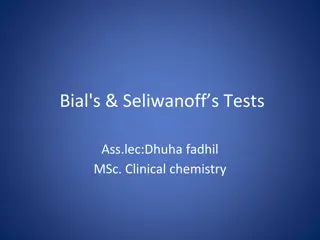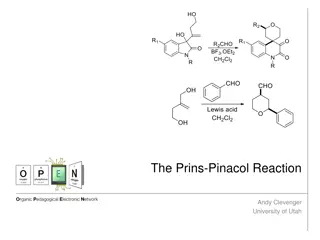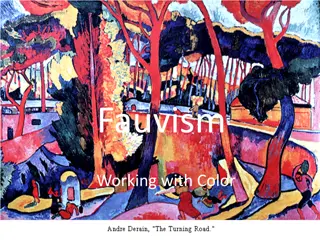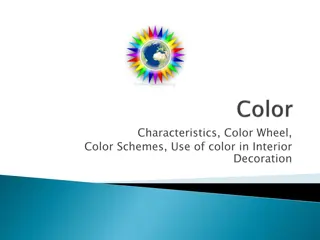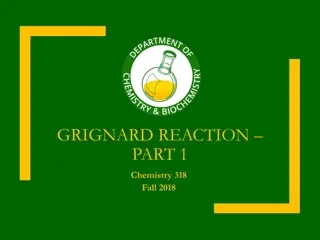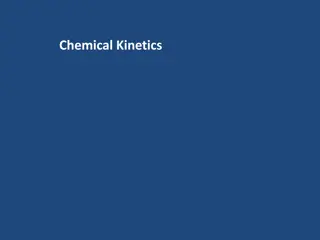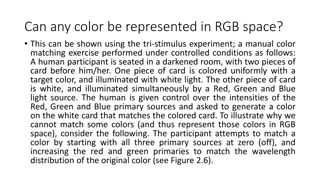Understanding the Seliwanoff Color Reaction and its Significance
The Seliwanoff color reaction, discovered by Russian chemist Feodor Feodorovich Selivanov, is used to differentiate between aldoses and ketohexoses based on their dehydration and reaction with resorcinol in acidic conditions. Ketoses like fructose react faster than aldoses like glucose, leading to a deep cherry-red color formation, making it useful in detecting fructose in urine for conditions like fructosuria. This test showcases the unique properties of fructose as a ketose compared to glucose, highlighting its relevance in biochemical analysis.
Download Presentation

Please find below an Image/Link to download the presentation.
The content on the website is provided AS IS for your information and personal use only. It may not be sold, licensed, or shared on other websites without obtaining consent from the author. Download presentation by click this link. If you encounter any issues during the download, it is possible that the publisher has removed the file from their server.
E N D
Presentation Transcript
The Seliwanoff colour reaction for fructose is due to the Russian chemist Feodor Feodorovich Selivanov The test, 0.1% resorcinol in 4M HCl, has been extended to ketohexoses which also give the deep cherry-red colour.
This indicates that ketoses are dehydrated more rapidly than aldoses to give a furan derivative that finally reacts with the reagent producing the observed colouration why ketoses react faster than aldoses in the same reaction conditions Since glucose reacts much slower than fructose as observed in the Seliwanoff s Test, we thought that this delay could be attributed to a previous isomerization of glucose to fructose
Fructose is an important and interesting ketose. It is well-tolerated by diabetics . Unlike glucose, fructose does not stimulate a substantial insulin release. Fructosuria is a rare disorder from liver malfunction. Fructose in urine can be detected by the Seliwanoff s Test This test showed that fructose reacts faster than glucose in order to give a positive result: patent with fructose and slightly pink with glucose.
The reaction consists in the triple dehydration of the monosaccharide to 5- hydroxymethylfurfural (ketohexoses) or to furfural (ketopentoses). Finally, the furan derivative reacts with resorcinol to give the coloured condensation product.
On dehydration both ketohexoes and aldohexoes give hydroxymethyl furfural but the relative amount of this product is vary according weather one works with aldoses or ketoses. Aldohexoes yeilding only small amount of the hydroxymethyl furfural which resposible for no significant change in the color or appearance of only light pink to yellow color which develop in longer time.
Take two clean, dry test tubes and add 1 ml of the test sample in one test tube. Add 2 ml of Seliwanoffs reagent to both the test tubes. Keep both the test tubes in a water bath for 1-2 min. Observe the formation of color and note it down.
1. This test is a generalized test and doesnt distinguish between specific ketoses, and a separate test is required for the particular ketose sugar identification.
Bials test (Orcinol) Bial s test is a chemical test performed to detect the presence of pentoses Objective To distinguish between the pentoses and hexoses. Reagent Bial's reagent consist of a solution of orcinol, HCl and ferric chloride)
pentoses are dehydrated by concentrated acid to yield furfural, which in turn condense with orcinol to form a blue-green precipitate. In the presence of hexoses, hydroxyfurfural is formed instead of furfural which upon condensation with orcinol forms a muddy brown colored precipitate. The intensity of the precipitation is directly proportional to the concentration of the pentoses in the sample.
bials test is a sensitive and specific test for pentoses sugars(ribose, ribulose, xylose, and arabinose)and other biochemical molecules containing these pentoses(what are they?) Pentoses give blue-green color complex within short time, some hexoses in prolonged heating yield hydroxymethylfurfural which react with orcinol to give muddy brown color complex.
) to 2 ml of Bials reagent add (5drops) of test solution(ribose or fructose) and warm gently in a hot water bath for 1-2 minutes. 2) a bluish green color indicates a positive result (pentoses). Prolonged heating form muddy brown products indicates (hexoses). NOTE:- The dehydration agent is HCL. The condensation agent is orcinol and ferric chloride.
Positive Bials test: formation of blue color ( eg. Ribose sugar) Negative Bial s test: formation of any other color indicates negative test. Hexose sugar ( glucose, fructose) generally gives green, red or brown color product.
This test is used to detect the presence of pentose in a given sample This test can additionally be used for the quantification of RNA in a sample





